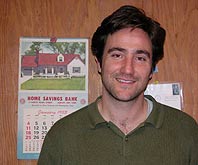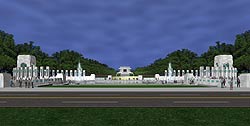Berkeleyan
For the sake of the dead, or the living?
Berkeley prof explores the tensions that surface when it comes time to memorialize a war
![]()
| 17 November 2004
Andrew Shanken was writing his dissertation on the culture of wartime architecture in the United States during World War II at Princeton University when he made a fortuitous discovery.
“Before the war ended, there was an aggressive debate about what shape the post-war memorials would take,” says the assistant professor in architecture at Berkeley. “I thought it was strange to plan ahead for memorials. We tend not to think about planning for death and, since there was a big taboo against death in that period too, it seemed all the more interesting to research.”
 Andrew Shanken (Wendy Edelstein photo) |
The resulting article, “Planning Memory: Living Memorials in the United States During World War II,” was published in the March 2002 issue of Art Bulletin, eventually winning an award for the best article in art history by a writer under 35, and dramatically changing Shanken’s life. “It’s the only thing of note I’ve published,” he says. “Everything that I’ve done in this field — all my grants and this job — are in a certain sense owed to that one piece.”
Shanken’s article explored the shift in American public opinion between the two world wars over how fallen soldiers ought to be remembered. Traditional memorials — statues, obelisks and cenotaphs, triumphal arches, and the like — were popular after World War I. The tide radically shifted, however, during the next global conflagration. Public opinion largely favored “living memorials” — community centers, libraries, forests, even highways marked with a plaque — as a way to remember the casualties of wartime. The World War I tributes that dominated the American memorial landscape were lambasted, wrote Shanken, “for their clutter, sense of age and decay, vulgarity and expense, and superfluousness and ineffectiveness, among other things.”
He continued: “While the traditional memorial generally has been associated with the heroics of war, sacrifice, death, or victory, the living memorial eschewed many of these associations for a celebration of democracy, community, the pursuit of ‘better living.’”
The curious siting of America’s newest memorial
Nearly 60 years after the end of World War II, the deliberations over how to remember American war dead continue — most recently over the siting and design of Friedrich St. Florian’s National World War II Memorial. The completed memorial is located on the National Mall in Washington, D.C., between the Washington Monument and the Lincoln Memorial. Its design, which evokes the traditional approach to memorial-building with its 56 stone pillars and two 43-foot-high arched pavilions, has been widely criticized, but it’s the siting that Shanken finds particularly curious.
 The National World War II Memorial in Washington, D.C., honors the 16 million American men and women who served in the Second World War, the more than 400,000 who died, and all who supported the war effort from home. It opened to the public in April of this year, after nearly three years of construction. Andrew Shanken, a new faculty member in the architecture department, thinks the memorial’s location, between the Washington Monument and Lincoln Memorial on the National Mall, elevates WWII in importance over the Vietnam war — an arguable judgment, he suggests. |
Critiques of the proposed World War II Memorial came from many other corners, wrote Shanken, including New York Times architecture critic Herbert Muschamp and syndicated columnist (and recent California gubernatorial candidate) Arianna Huffington. Muschamp asserted that the monument did not say anything significant about the past but instead “puts sentiment in the place where knowledge should be.” For her part, Huffington appealed to our collective sense of priorities, arguing that “when we make an edifice to the dead and dying more important than our obligations to honor the living” we forget about “the 275,000 chronically homeless veterans and the other 500,000 veterans who find themselves homeless at some time during the year.”
Both Tom Hanks (post-Private Ryan) and former Vice President Bob Dole took to the lecture circuit to advocate for the memorial. Their argument was that while 50 years have passed since the end of WWII, veterans of that war, who are dying at a rate of 20,000 a month, had yet to see a memorial built to honor their service. Celebrity backing helped raise enough money to build the National World War II Memorial, which, at a cost of $175 million, is the most expensive memorial ever erected.
“The funny thing is,” says Shanken, “that the majority of people who fought in that war died before the memorial was built. It raises the question of why we build memorials — so that later generations don’t forget, or for people who suffered through the event itself?”
Shanken links American leeriness of traditional memorials to their great expense, which “we have trouble justifying” because the structures are for commemorative purposes and don’t foster meditation on forward-looking social ideas. “I think there’s something sustained and abiding in the American spirit that struggles with excess,” he says, “at least that sort of public excess in which the government is involved.”
But regardless of whether we choose to remember our veterans with a memorial highway or a traditional bronze soldier, “These projects help us do what some people call ‘memory work,’” says Shanken. “There’s a welling up of democratic debate around many memorial projects,” he says, because of their cost and the public land they occupy. The debate, Shanken contends, is as important as visiting the memorial itself.

